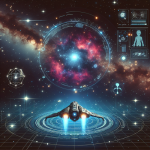
How AI is Revolutionizing Space Exploration
How AI is Revolutionizing Space Exploration
Space exploration has always been a field driven by the limits of human imagination and technological capability. The integration of Artificial Intelligence (AI) into this realm marks a pivotal transformation, making space missions more efficient and expansive. This article explores the profound impact of AI on space exploration, showcasing its applications from mission planning to celestial navigation.
AI in Mission Planning
AI’s role begins before the spacecraft even leaves Earth. Advanced algorithms process vast amounts of astronomical data, allowing scientists to identify key mission parameters. These algorithms are capable of predicting optimal launch windows, trajectory paths, and potential hazards, effectively enhancing the accuracy of mission planning. For instance, AI tools for automating reports are integral in generating precise mission summaries quickly.
Autonomous Navigation and Rovers
In deep space, communication delays can be lengthy. AI enables real-time decision-making capabilities on planetary rovers and exploration drones. On the Martian surface, AI assists rovers in obstacle avoidance and navigation, enhancing their ability to explore and conduct experiments independently. This autonomy ensures that the rover can carry out its mission without waiting for human commands, thereby optimizing operational efficiency.
Case Study: NASA’s Perseverance Rover
The Perseverance Rover is equipped with AI-powered systems that allow it to analyze the Martian terrain in real-time. This capability enables it to perform scientific experiments, sample collections, and even identify signs of ancient life autonomously.
AI and Robotics: A Synergistic Approach
AI algorithms also enhance the functionality of space-bound robotics. These algorithms enable robotic arms on spacecraft to carry out complex manipulations for repairs or scientific operations in the vacuum of space. AI-driven simulations allow scientists to predict mechanical failures and schedule predictive maintenance, reducing risks and costs associated with manual interventions.
Analyzing Extraterrestrial Data
Space missions generate enormous amounts of data. AI efficiently analyzes this information, helping scientists interpret astrobiological signals and geological formations. Machine learning models sift through terabytes of image and sensor input, identifying patterns and anomalies that may hold clues to understanding the universe.
Enhancing Future Missions
The future of AI in space exploration holds promise. As AI technologies advance, they are likely to be integrated into crewed missions, assisting astronauts with task automation and emergency protocols. This will prove vital for long-duration missions, possibly aiding in humanity’s journey to Mars.
Troubleshooting and Limitations
While AI offers numerous benefits, its implementation in space is not devoid of challenges. Ensuring AI systems can withstand cosmic radiation and harsh environmental conditions is crucial. Moreover, developing fail-safe mechanisms is necessary to prevent AI malfunctions from jeopardizing missions.
Summary Checklist
- Understanding AI’s application in mission planning and trajectory calculations.
- The role of AI in enhancing autonomous rover navigation.
- Exploring AI’s integration with robotics for space operations.
- Analyzing extraterrestrial data with machine learning models.
- Troubleshooting AI’s challenges in space environments.
AI stands at the forefront of modernizing space exploration, presenting potential that could take humanity to the stars. As we harness more potent AI technologies, the universe’s mysteries become increasingly reachable.











